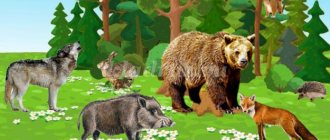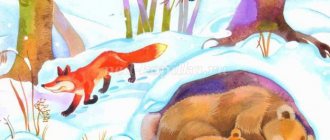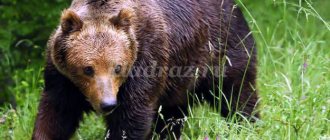MAGAZINE Preschooler.RF
“Wild Animals” Goals: development of children’s cognitive interests, intellectual activity, connected speech. Educational objectives: to cultivate interest in learning, activity, organization. Introduce basic generally accepted rules and norms of behavior. Foster an attentive and caring attitude towards nature and animals. Developmental tasks: develop the ability to think logically, reason, analyze. Develop the ability to use verbal and non-verbal means of communication. Develop imagination, imagination, fine motor skills. Educational objectives: to teach children to compose descriptive stories, to clarify and consolidate children’s knowledge about animals, their names, external signs, habits, methods of movement, their classifications, structure, nutrition, and habitat. Show their adaptability to life in the forest. Show the color and diversity of the animal world. Develop the ability to form complex adjectives, possessive adjectives, nouns using the suffix -ish; selection of antonym words; agree numerals with nouns; practice selecting epithets; develop vocabulary on this topic. Main educational area: communication. Integrated educational areas: cognition, socialization, reading fiction, physical education, safety, music. Methods: gaming, practical, visual, verbal, search and research. Techniques: questions, instructions, additions, reminders, artistic expression, encouraging assessment. Visual teaching aids: pictures of wild animals. "Forest" layouts. Outline for storytelling. Children's encyclopedia. Pictures For the games “Whose house?”, “Whose tail?”, “Food Chain”, animal figures. Vocabulary work: to activate words on the topic “Wild Animals” in children’s speech. Exercise children in forming adjectives from nouns. Develop the ability to form complex adjectives, possessive adjectives, nouns using the suffix -ish; selection of antonym words; agree numerals with nouns; practice selecting epithets; develop vocabulary on this topic. Preliminary work: Looking at paintings with animals. Reading stories and conversations about animals, reading encyclopedias. Free activity drawing of animals. Preparation of handouts and demonstration materials, artistic expression. Structure 1. Psychological mood, introductory organizational moment, surprise moment. 2. Game “Riddles - guesses”. 3. Physical education minute. Psycho-gymnastics “Teddy Bear”. 4. Game “Riddles - guesses”. 5. Didactic game “Finish the sentence.” 6. Summary of the lesson Progress of the educational activity itself 1. Organizational moment - Guys, I received a letter by email, let's open this letter (we open it). These are riddles! Do you like to solve riddles? (yes) ____________________ 2. Game “Riddles - guesses”. The speech therapist displays pictures of animals. -What are these animals called? (Wild.) Why? a) The speech therapist asks a riddle: A cunning cheat, A red head, A fluffy tail - a beauty - And her name is... (Fox.) - Which fox? (Cunning, fast, red-haired, dexterous...) -Who else lives with the fox? (fox, little fox, fox cubs.) Didactic game “Whose is this?” (based on pictures) (Fox face, fox ears, etc.) Formation of complex adjectives: - The fox has thin paws. What fox? (Thin-pawed.) - The fox has a long nose. —The fox has sharp ears. —The fox has a short mustache. —The fox has a red tail. —The red fox has beautiful thick, fluffy fur. Her body is very mobile, it can bend and stretch when running. The fox has a long fluffy tail. The muzzle is elongated, the ears are pointed and erect, the eyes have oval pupils. The fox's legs are short and thin. She is an omnivore, but loves fresh meat most of all. Hunts mice, water rats, hares. The fox has good hearing and sense of smell. In winter, she hears mice squeaking under a layer of snow. The fox quickly digs up the snow and catches them. She also has many enemies, of which the most dangerous is the wolf. b) The speech therapist asks a riddle: In summer he walks with a clubfoot, and in winter he sucks his paw. (Bear.) -What bear? (Clubfooted, clumsy, brown, shaggy...) - Didactic game “Whose is this?” (Based on pictures.) (Bear's paw, etc.) -Name the members of the bear's family. (Bear, she-bear, cub, cubs.) -What is the name of the bear’s home? (Den.) -The bear has a huge, clumsy body covered with brown fur. He has a large head, a short and thick neck, and small eyes. The bear has poor eyesight. The ears are small and round. When walking, he places his paws inward with his claws and outward with his heels. That's why the bear was called clubfoot. The bear is a very strong animal. It feeds on mushrooms, berries, nuts, birds living on the ground, and small animals. He especially loves to eat honey, and even got his name for this - a bear: he knows where the honey is. In autumn, it feeds intensively and accumulates fat. With the onset of cold weather, the bear falls asleep in its den. c) The speech therapist asks a riddle: Who wanders around angry and hungry in the cold winter? (Wolf.) - Continue the sentence according to the meaning: The wolf is the dad in the family of wolves. Mom - ... (she-wolf). Children - ... (wolf cubs). Formation of nouns with a diminutive suffix and using the suffix -ish: - The she-wolf has a mustache. The wolf cub has mustaches. The wolf has a mustache. (Similarly: eyes, nose, tail.) - Which wolf? (Angry, hungry, gray, toothy, fanged, shaggy...) Didactic game “Whose is this?” — Among wild animals, the wolf stands out for its strength, intelligence, and endurance. The wolf has coarse, thick fur, a large head, a wide forehead, a thick neck, protruding ears, and sharp teeth. The wolf has well-developed paws. They are tall, strong, have strong sharp claws. The wolf has excellent eyesight. He sees even in the dark. Hearing is acute. Can hunt for prey for a long time. And as soon as she loses strength and cannot run, the wolf immediately attacks her. The wolf is a predatory animal, it eats meat, but only weak, sick animals become its prey. It’s not for nothing that this predator is called the “forest orderly.” The wolf lives in a den, which he makes not far from a pond, in a remote place. d) The speech therapist asks a riddle: You and I recognize the animal by these two signs: He wears a white fur coat in the winter, And a gray fur coat in the summer. (Hare.) - Which hare? (Fast, cowardly, gray, white, dexterous...) Didactic game “Say the opposite”: black - white,) brave - cowardly, fast - slow, cheerful - sad, smart - stupid, long - short. — The hare has beautiful, fluffy, soft fur. During a jump, the hare throws forward first its long hind legs, and then its short front legs. Doesn't make holes. During the day it lies under a bush and at night it gets its food. In summer it eats grass, in winter it eats hay, bark of trees and shrubs. The hare has many enemies: fox, wolf, hawk, owl, eagle. In winter, its white color saves it. 3. Physical education session Psycho-gymnastics “Teddy bear” (to the music of MPZ) children perform movements in accordance with the words. The clubfoot bear was walking through the forest, the children walked imitating the walking of a bear. He chose a place for his den, put his hand to his forehead, looked in different directions. Under a tall pine tree he began to dig the ground, imitating digging with his hands. He dug a den and went to bed. Place two palms together under your ear. Snowflakes stars fell from the sky, hands waving up and down. Snow covered the paths and houses and forest. hands waving left and right. And all winter the wind in that forest rustled, lips blowing like a tube, and all winter the bear under the pine tree snored, putting two palms together under its ear. 4. Game “Riddles - guesses”. a) The speech therapist asks a riddle: The tail is a fluffy arch. Do you know this animal? Sharp-toothed, dark-eyed, loves to climb trees. He builds his house in a hollow, so that the beast can live in warmth. (Squirrel.) -Which squirrel? (Fast, dexterous, beautiful, fluffy, nimble redhead...) -Count how many squirrels are in the picture? (one squirrel, two squirrels...\ -The big squirrel is the mother. What is it called? (Squirrel.), the little ones are children. What are they called? (Squirrels.) And one (Squirrel.) Didactic game “Whose is this? "- The squirrel is a small, defenseless animal. It has fluffy, reddish fur, bulging black eyes. A large fluffy tail, the size of the squirrel itself. Ears with tassels stick out on the back of the head. The squirrel's teeth are large, curved and very sharp. It feeds on nuts and seeds coniferous trees. For the winter, she stores nuts and acorns in hollows, dries mushrooms on the branches of bushes. The squirrel escapes from enemies only by hiding in dense tree branches and hollows. b) The speech therapist asks a riddle: An angry touch-me-not lives in the wilderness of the forest. There are a lot of needles, but not a single thread. (Hedgehog) - What hedgehog? (Prickly, angry, dexterous, fast, brave, smart...) - Name his family. (Hedgehog, hedgehog, hedgehog, hedgehog.) 5. Didactic game “Finish the sentence.” -You saw (who?) ... a hedgehog in the forest. We admire (who?) ...a hedgehog. We liked (who?) ... the hedgehog. We will give milk to (who?) ... the hedgehog. I told you (about whom?) ... about the hedgehog. —The hedgehog is an amazing animal, adapted to the most dangerous situations. Its body is covered with hard protruding needles. When in danger, the hedgehog curls up into a ball, and it turns out to be a needle-shaped ball that you can’t handle. The animal feeds on bugs, worms, and frogs. In winter, the hedgehog sleeps in a hole under the root of a large tree. c) The speech therapist shows a picture and talks about the moose. — Elk is a very large animal. He has high legs and a relatively short body. The large head has horns. The color of the moose is brownish-black. In summer, moose eat leaves, berries, and mushrooms. In winter, digging out snow, it looks for dry grass and eats tree bark. 6. Summary of the lesson Material for consolidation I. Clarify why they are called wild animals, what they eat, how they move, where they live. Know the names of the cubs, family. Choose epithets for each animal. Write a story about any animal. II. Grammatical structure of speech and word formation. 1. Formation of plural nouns in the nominative and genitive cases. For example: wolf - wolves - wolves, etc. Formation of nouns with a diminutive suffix. For example: squirrel - squirrel, etc. 3. Formation of complex adjectives. For example: A fox has a long tail. What fox? - Long-tailed. The hare has a short tail - ... thin paws - ..., short paws - ..., thick paws - ..., long ears - ..., pointed ears - ..., short mustache - .... 4. Formation of possessive adjectives. For example: Fox hole. Whose hole? - Fox's den. Bear's den. -...The hollow of a squirrel. -...The wolf's lair. -... The face of a fox. -...Hare's tail. - ... 5. Formation of nouns using the suffix -ish. For example: nose - nose, etc. (paws, tail, mustache, eyes, teeth) 6. Selection of antonym words. For example: The fox has a long tail, and the hare has a short tail. The bear has thick paws, and the fox... etc. 7. Agreement of numerals with nouns. Didactic game "Count". 8. Strengthen the use of prepositions: on, with, around, between, because of, about. Make up sentences with these prepositions and write them down in your notebook.








